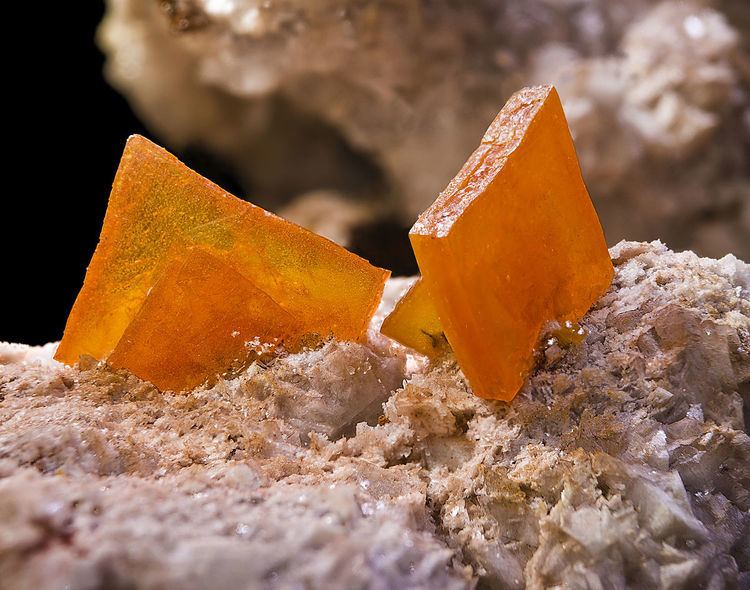Strunz classification 7.GA.05 Space group I41/a | Formula(repeating unit) PbMoO4 Crystal system Tetragonal | |
 | ||
Crystal class Dipyramidal (4/m)H-M symbol: (4/m) | ||
Wulfenite is a lead molybdate mineral with the formula PbMoO4. It can be most often found as thin tabular crystals with a bright orange-red to yellow-orange color, sometimes brown, although the color can be highly variable. In its yellow form it is sometimes called "yellow lead ore".
Contents
It crystallizes in the tetragonal system, often occurring as stubby, pyramidal or tabular crystals. It also occurs as earthy, granular masses. It is found in many localities, associated with lead ores as a secondary mineral associated with the oxidized zone of lead deposits. It is also a secondary ore of molybdenum, and is sought by collectors.
Discovery and occurrence
Wulfenite was first described in 1845 for an occurrence in Bad Bleiberg, Carinthia, Austria. It was named for Franz Xavier von Wulfen (1728–1805), an Austrian mineralogist.
It occurs as a secondary mineral in oxidized hydrothermal lead deposits. It occurs with cerussite, anglesite, smithsonite, hemimorphite, vanadinite, pyromorphite, mimetite, descloizite, plattnerite and various iron and manganese oxides.
A noted locality for wulfenite is the Red Cloud Mine in Arizona. Crystals are deep red in color and usually very well-formed. The Los Lamentos locality in Mexico produced very thick tabular orange crystals.
Another locality is Mount Peca in Slovenia. The crystals are yellow, often with well-developed pyramids and bipyramids. In 1997, the crystal was depicted on a stamp by the Post of Slovenia.
Lesser known localities of wulfenite include: Sherman Tunnel, St. Peter’s Dome, Tincup-Tomichi-Moncarch mining districts, Pride of America mine and Bandora mine in Colorado.
Small crystals also occur in Bulwell and Kirkby in Ashfield, England. These crystals occur in a galena-wulfenite-uraniferous asphaltite horizon in a magnesian limestone. The wulfenite found in this area is similar in properties (paragenetic sequence, low silver and antimony contents of the galenas and absence of pyromorphite) to the wulfenites of the Alps and may be similar in origin.
Crystallography
Wulfenite crystallizes in the tetragonal system and possesses nearly equal axial ratios; as a result, it is considered to be crystallographically similar to scheelite(CaWO4). Wulfenite is classed by a pyramidal-hemihedral (tetragonal dipyramidal) (C4h) crystal symmetry. Therefore, the unit cell is formed by placing points at the vertices and centers of the faces of rhomboids with square bases and the crystallographic axes coincide in directions with the edges of the rhomboids. Two of these lattices interpenetrate such that a point on the first is diagonal to the second and one quarter the distance between the two seconds.
An extensive solid solution exists between the two end members wulfenite and stolzite (PbWO4), such that tungstenian-wulfenite compositions range from 90% wulfenite and 10% stolzite to chillagite (64% wulfenite, 36% stolzite) and so on. Nevertheless, the Commission for New Minerals and Mineral Names of the International Mineralogical Association has deemed that the solid solutions do not require new names. The correct nomenclature of the 90:10 solid state is wulfenite-I41/a and the 64:36 solid state is wulfenite-I4. The structure of the wulfenite-I41/a system can be described as a close packing of tetrahedral MoO42− anions and Pb2+ cations. In the lattice, the MoO42− anions are slightly distorted, though the bond lengths remain equal and the oxygens are linked through Pb-O bonds. Each lead atom has an 8-coordination with oxygen and two slightly different Pb-O bond distances. This structure closely resembles that of pure wulfenite.
The structure of wulfenite-I4 is also very similar to that of wulfenite-I41/a but has an unequal distribution of tungsten and molybdenum which may explain the observed hemihedrism.
It is argued that no miscibility gap exists in the wulfenite-stolzite solid solution at room temperature due to the almost identical size and shape of the MoO42− and WO42− ions, however, arguments have been made for the existence of a miscibility gap at higher temperatures.
Hemihedrism
The crystals of wulfenite are usually more tabular and thinner than those of scheelite, however, the more pyramidal and prismatic crystals show distinct hemimorphism.
Thermodynamics and reactivity
The heat capacity, entropy and enthalpy of wulfenite were determined taking into consideration the existence of solid solutions and the inclusion of impurities. The reported values are as follows: Cp°(298.15) = 119.41±0.13 J/molK, S°(298.15) = (168.33±2.06)J/molK, ΔH°= (23095±50) J/mol.
When forced through a tube into a flame, wulfenite disintegrates audibly and fuses readily. With the salt of phosphorus, it yields molybdenum beads. With soda on charcoal it yields a lead globule. When the powdered mineral is evaporated with HCl, molybdic oxide is formed.
Molybdenum can be extracted from wulfenite by crushing the ore to 60-80 mesh, mixing the ore with NaNO3 or NaOH, heating the mixture to about 700 °C (decomposing), leaching with water, filtering, collecting the insoluble residues which may include Fe, Al, Zn, Cu, Mn, Pb, Au and Ag, then the NaMoO4 solution is agitated with a solution of MgCl2, filtered, CaCl2 or FeCl2 or any other chlorides is added to the Mo solution and heated and agitated, filtered and the desired product is collected. The full process is patented by the Union Carbide and Carbon Corp.
